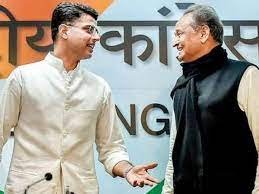In a significant development aimed at resolving internal conflicts within the Congress party, Congress President Mallikarjun Kharge took the initiative to bring together two prominent leaders, Rajasthan Chief Minister Ashok Gehlot and his former Deputy Chief Minister, Sachin Pilot. The meeting, which took place on May 29, was also attended by senior party leader Rahul Gandhi, signifying the importance of the discussions and the party’s commitment to finding a peaceful resolution.
The meeting, described as a marathon four-hour session, was conducted with the primary objective of formulating a “peace formula” that could bridge the gap between the two warring factions within the Congress party in Rajasthan. The prolonged rift between Gehlot and Pilot had resulted in a period of political turmoil within the state, leading to speculation and concerns about the party’s stability and prospects in the upcoming elections.
The outcome of the meeting brought much relief and optimism as the Congress announced that Gehlot and Pilot would contest the elections unitedly. The party’s willingness to release pictures of the closed-door meeting, where Gehlot and Pilot were seen relaxed and smiling, further demonstrated the positive atmosphere and progress made during the discussions.
The resolution of internal conflicts within a political party is crucial for its overall stability and effectiveness. The Congress leadership, recognizing this, took a proactive step by facilitating the meeting between Gehlot and Pilot. The presence of Rahul Gandhi, a key party figure, underscored the seriousness and commitment of the Congress in resolving the long-standing dispute.
The discussions during the meeting likely revolved around addressing the grievances and concerns of both leaders, as well as finding common ground to ensure a united front for the upcoming elections. The Congress leadership, through Kharge’s efforts, may have played a crucial role in mediating between the two leaders, encouraging open communication, and emphasizing the importance of party unity.
The decision to contest the elections together sends a strong message of solidarity and unity within the Congress party. It not only boosts the morale of party workers but also presents a formidable challenge to rival political parties. The Congress has a long history of rallying behind its leaders and presenting a united front during elections, and the resolution of the Gehlot-Pilot conflict reinforces this tradition.
The successful resolution of internal conflicts in Rajasthan could have wider implications for the Congress party at the national level. It showcases the party’s ability to address internal differences and work towards maintaining a cohesive structure. Additionally, it sets a positive example for other state units within the party, inspiring them to prioritize unity and resolve disputes amicably.
The Congress party’s efforts in bringing Gehlot and Pilot together should be commended as it reflects a commitment to internal democracy and the value of consensus-building. The peace formula, devised through extensive discussions, is a testament to the party’s dedication to resolving conflicts within its ranks.
Moving forward, the Congress party will need to ensure that the unity achieved in Rajasthan is sustained and translated into a robust electoral campaign. The leadership should continue to foster an environment of trust, communication, and cooperation among its leaders to maximize their collective potential.
Overall, the meeting between Mallikarjun Kharge, Ashok Gehlot, and Sachin Pilot, with the presence of Rahul Gandhi, represents a significant step forward in resolving the internal conflicts within the Congress party. The decision to contest the elections unitedly and the positive atmosphere captured in the released pictures indicate a renewed sense of cohesion and determination within the party. As the Congress prepares for the upcoming elections, the successful resolution of the Gehlot-Pilot conflict serves as a beacon of hope and unity for the entire party.



